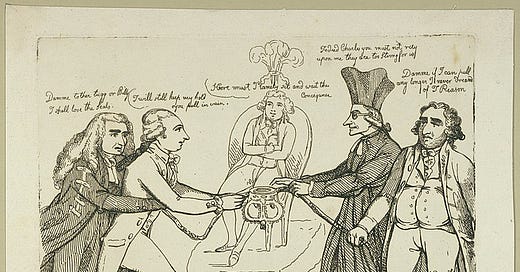Political Spectrums Based on Myopia and Political Narcissism
Chapter 4.5: Spectrums based on political rivalry, reprise
Why this book | Title Page | Table of Contents
Preface | Introduction
PART 1
Chapter 1 (1.1) (1.2) | Chapter 2 (2.1) (2.2) (2.3) | Chapter 3 (3.1) (3.2) (3.3) (3.4) (3.5) (3.6)
PART 2
Chapter 4 (4.1) (4.2) (4.3) (4.4) (4.5) | Chapter 5 | Chapter 6
PART 3
Chapter 7 | Chapter 8 | Chapter 9 | Chapter 10 | Chapter 11 | Chapter 12 | Chapter 13 | Chapter 14
PART 4
Chapter 15 | Chapter 16 | Chapter 17 |
PART 5
Chapter 18 | Chapter 19 | Chapter 20 | Conclusion
Appendix | Works Cited
4.5
Spectrums based on political rivalry, reprise
Whigs and Tories
Spectrums based on political rivalry, reprise
We can move our analysis away from the modern left’s conception of the political spectrum and still see the kinds of problems that arise from using relative and context-dependent units of measure.
Whigs and Tories
Narrow-focus spectrums miss the bigger picture
Let us use, for our example, the case of the Whigs and Tories. These two British political parties, and the movements they represented, were the primary political forces in Britain for nearly two hundred years—contending for power from the later seventeenth century through the middle of the nineteenth. Radicals, Jacobites, and others came and went, some finding temporary homes within these parties, but the Whigs and Tories were the main players—duking it out politically, while shepherding Britain into empire and modernity.1
Though the modern political designations of left and right did not arise until halfway through this period, today’s relativistic understanding would have placed the Whigs to the left and the Tories to the right. The Whigs, broadly speaking, represented the forces of reform and liberalization. The Tories largely sought to conserve more “traditional” ways of ordering society.
But how different were they, really?
Upgrade today to continue reading…
Keep reading with a 7-day free trial
Subscribe to The Freedom Scale to keep reading this post and get 7 days of free access to the full post archives.



